By Robert Bernstein
What is life like for the “iGen” which is the post-Millennial generation?
Dr. Jean Twenge has published a book to answer this question: “iGen: Why Today’s Super-Connected Kids Are Growing Up Less Rebellious, More Tolerant, Less Happy–and Completely Unprepared for Adulthood–and What That Means for the Rest of Us”.
Twenge delivered a sold-out talk at the Santa Barbara City College Garvin theater to present her findings. The event was part of the ongoing Mind and Supermind series of the School of Extended Learning.
Here are my photos, including many of her valuable informational slides!
SBCC professor Dr. Spencer Sherman introduced Dr. Twenge, noting her expertise in 130 scientific publications along with six books.

Then Dr. Twenge was off and running with non-stop images and data.
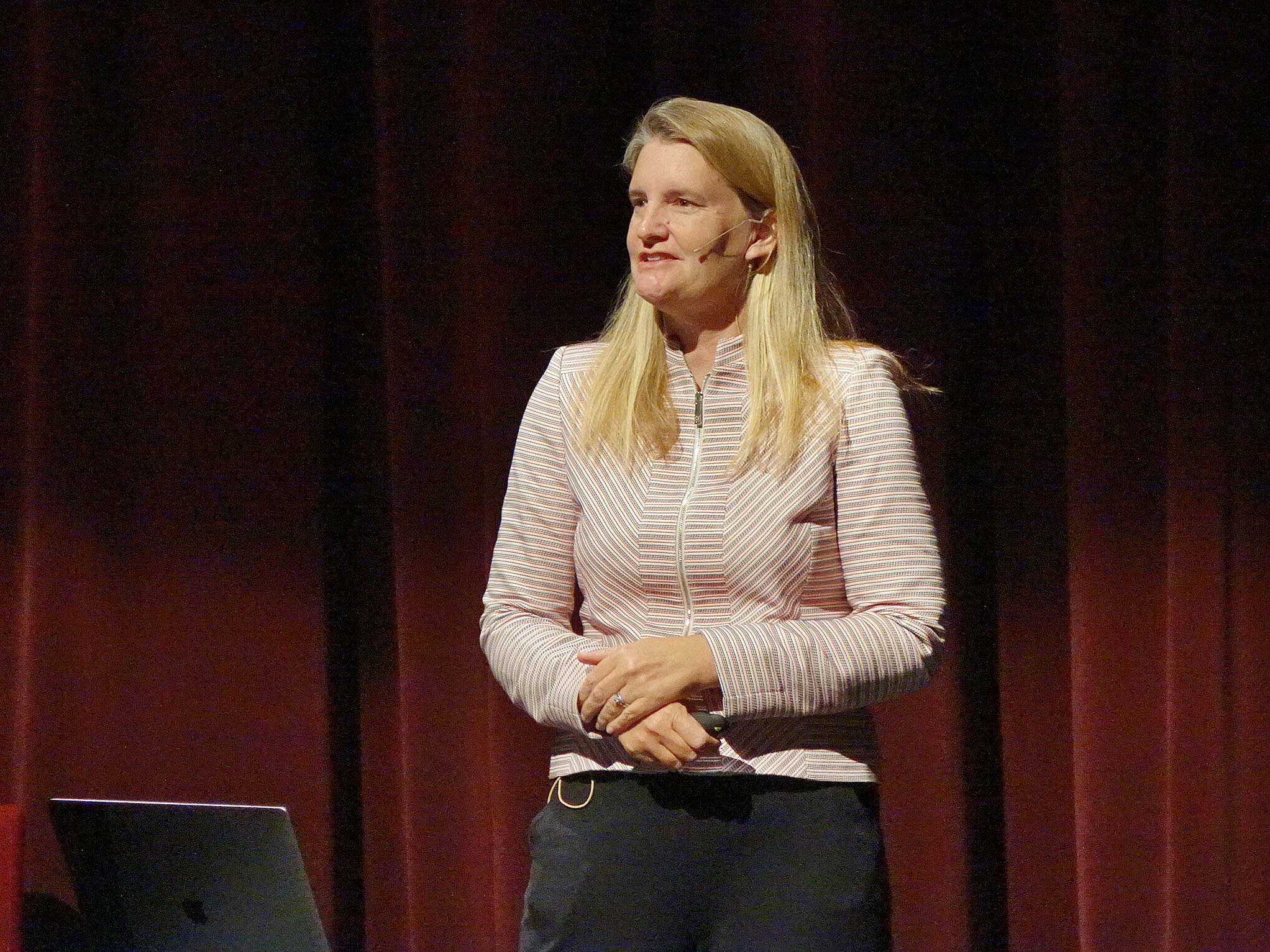
Starting with a run-down of the generation names and years:
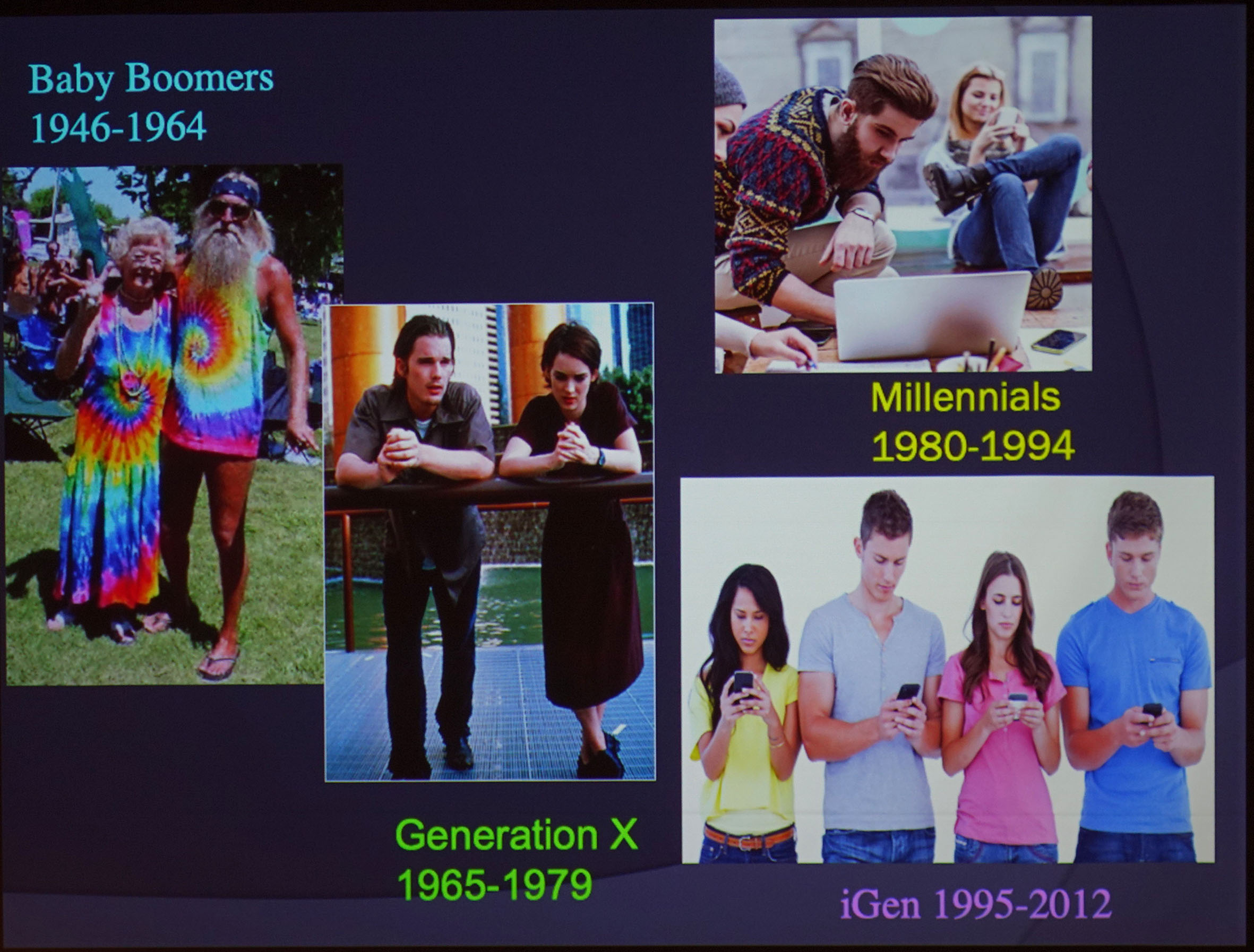
Twenge also notes that she has three daughters who are part of the iGen (born 1995-2012)
For data, she was able to turn to surveys conducted from 1966-2017 comparing these different generations when they were teens. 11 million people total.
TREND 1 – GROWING UP SPEED
The first trend she noticed was the speed of development for each generation. Each generation is like a completely different culture.
Notably, most kids don’t walk or bike to school by themselves anymore. Even though the percentage of kids within a mile of school has not changed!
If a kid is walking alone, the neighbors will often rush outside to escort the child back home!
Personal experience: I was teaching my neighbor’s boy to ride a bicycle. The parents were immigrants from China and they appreciated what I was doing. Until a “helpful” neighbor told them they could get in trouble if their son was seen biking alone. We live on a very quiet street similar to where I lived at that age and everyone I knew as a child biked alone any time we wanted.
Twenge called this a “Slow” life strategy: Have fewer kids and nurture each one carefully.
In contrast with the 1950s “Fast” life strategy: Many kids; survival mode.
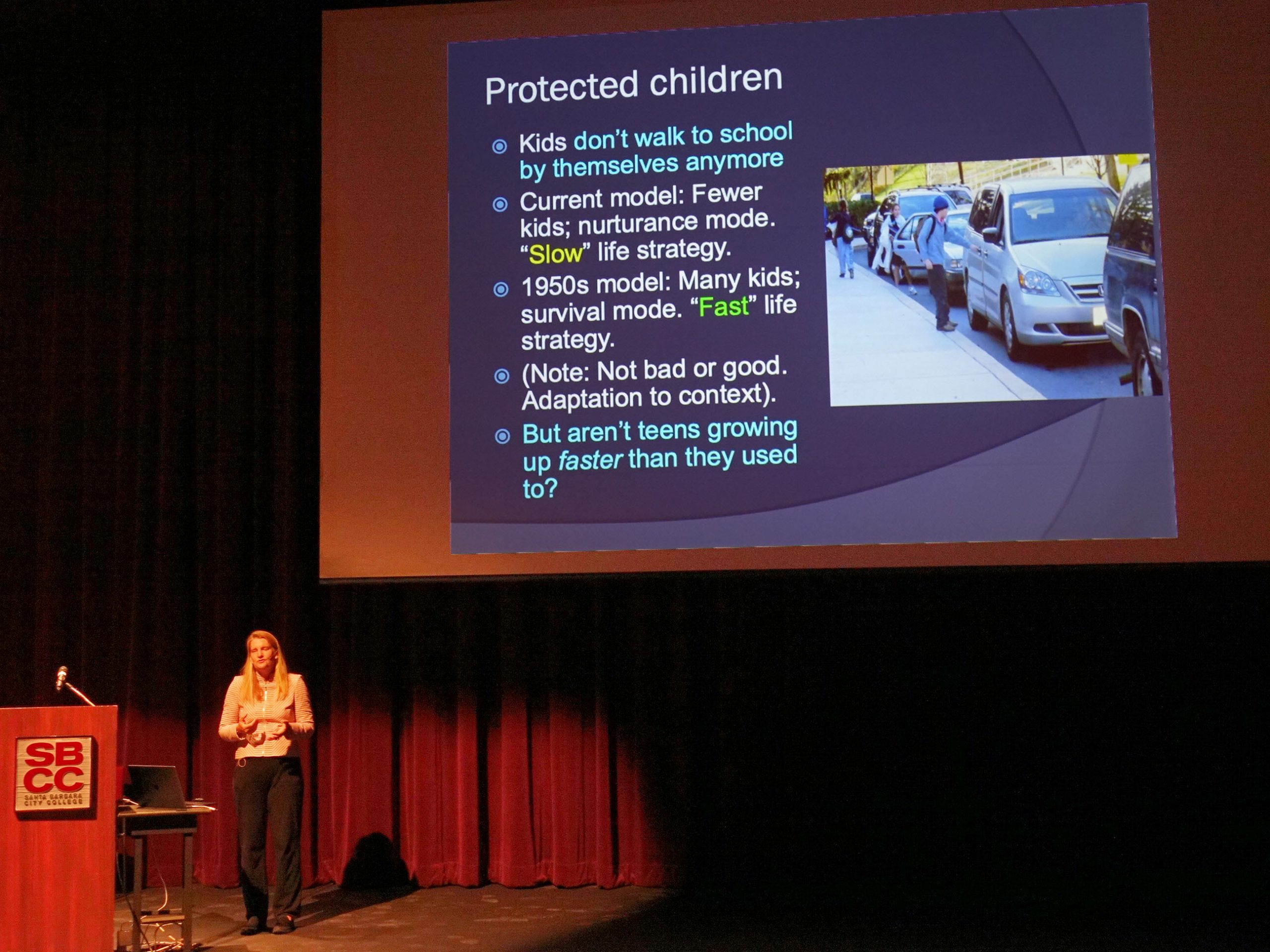
Personal experience: We had one rule which Twenge reminded us of: Be home in time for dinner. It worked well for everyone I grew up with in the 60s and 70s.
There is now a movement by people like Lenore Skenazy to restore this philosophy and she has published a book “Free Range Kids” to advance this mission.
Part of our expectation, as noted by Twenge: At age 18 we were to be out of the house. Either in college and/or working. In my case, it was age 17.
Twenge showed some photos of kids of my generation and earlier. What you see right away is a sense of teens being independent and making their own decisions.
Here were some photos from 1972-73 by photographer Bill Yates showing what she meant:
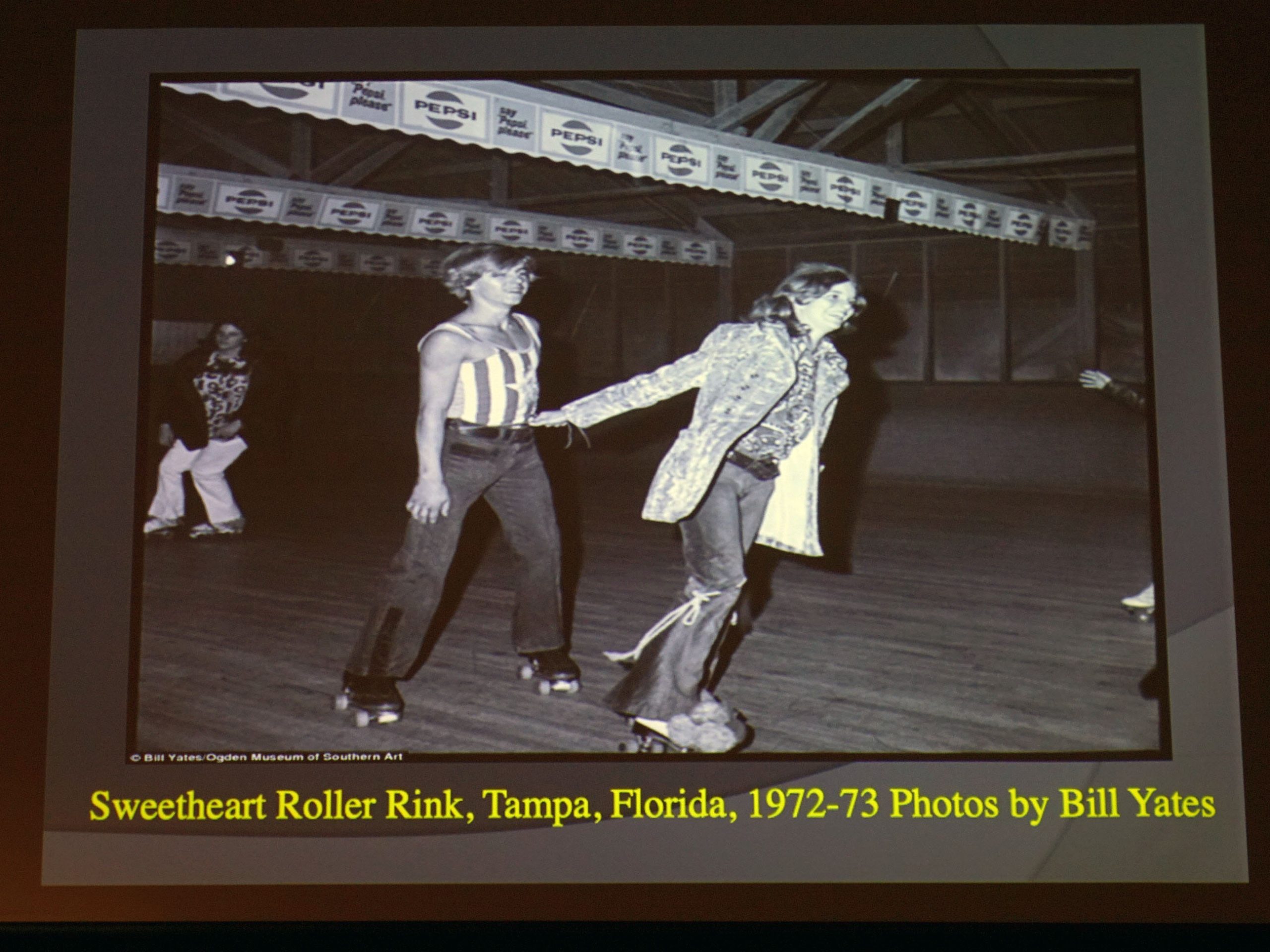

“Did you know this kid?” She asked. Oh, wow. I totally knew that kid. I found him a bit scary! But we are now friends on Facebook and he hosted a high school reunion event for us!

Yes, some of their decisions were bad decisions. Smoking, drinking, early sex. But they were growing up.
The statistics show a decline of adult activities among 12th graders:
Driver’s License
Tried Alcohol
Ever been on a date
Ever worked during the school year
Ever had sex
Out without parents
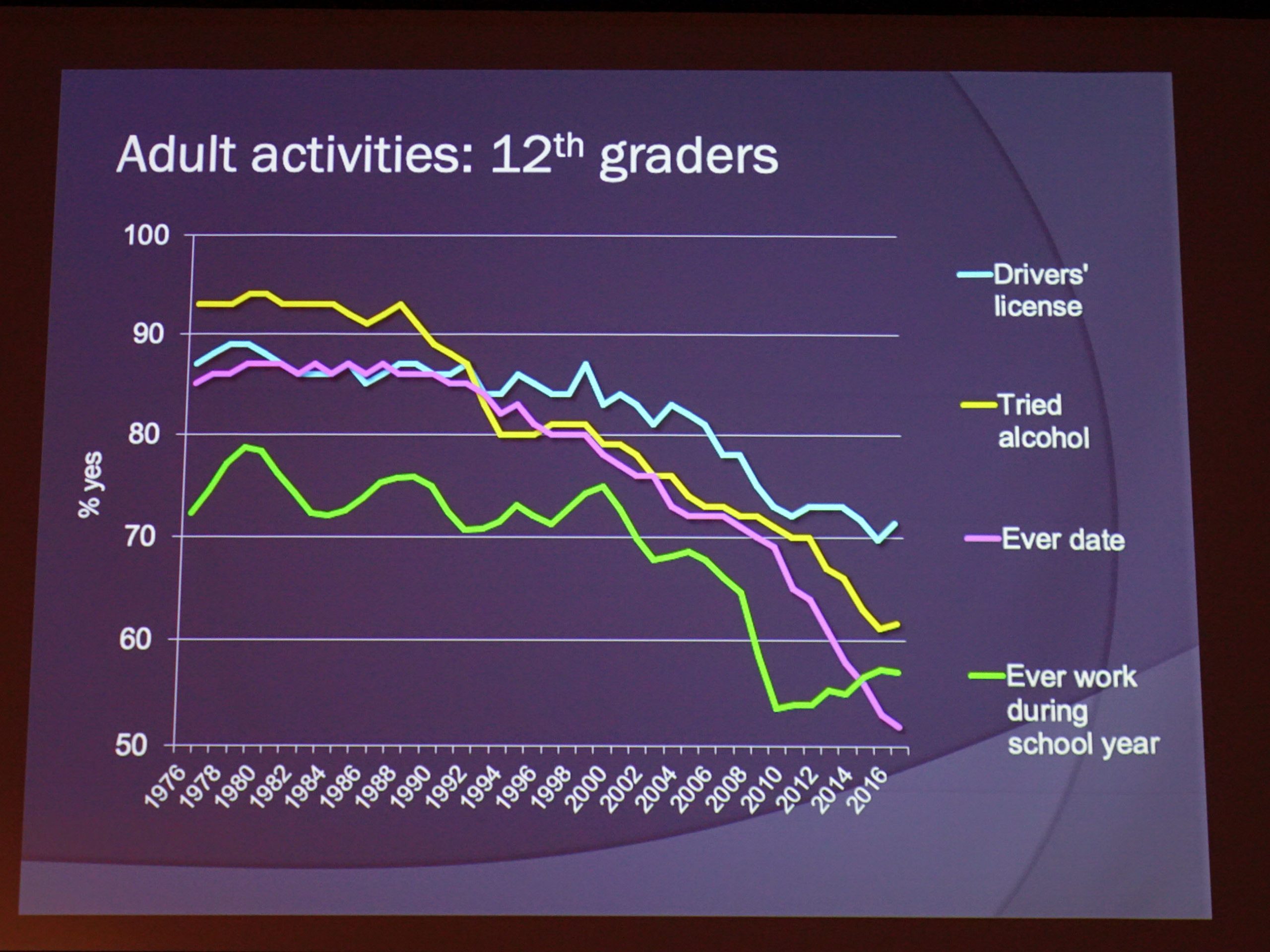
“Adult” is now a verb! As in “Don’t make me adult today.” There are even adulting classes!
Some are good trends. Certainly, kids are safer in some obvious ways.
But when kids finally do get away from home for the first time they are often unprepared. Many kids will be unable to make decisions without texting their parents. It is a tough adjustment.
Twenge recommends more opportunities for decision making while growing up. Constant reminders may be OK for small children. But that won’t be happening in college. Somewhere before that there better be a transition!
TREND 2 – MENTAL HEALTH/HAPPINESS
The second trend she noticed was mental health and happiness. She has researched this for 25 years. Everything changed starting in 2011-2012.
More teens saying they felt lonely or left out. Signs of clinical depression. The data is real. As borne out by emergency room visits for self-harm and suicide rates.
Teen happiness had been going up. Until it turned sharply down. Along with life satisfaction and self-esteem. All changed in 2011-2012.
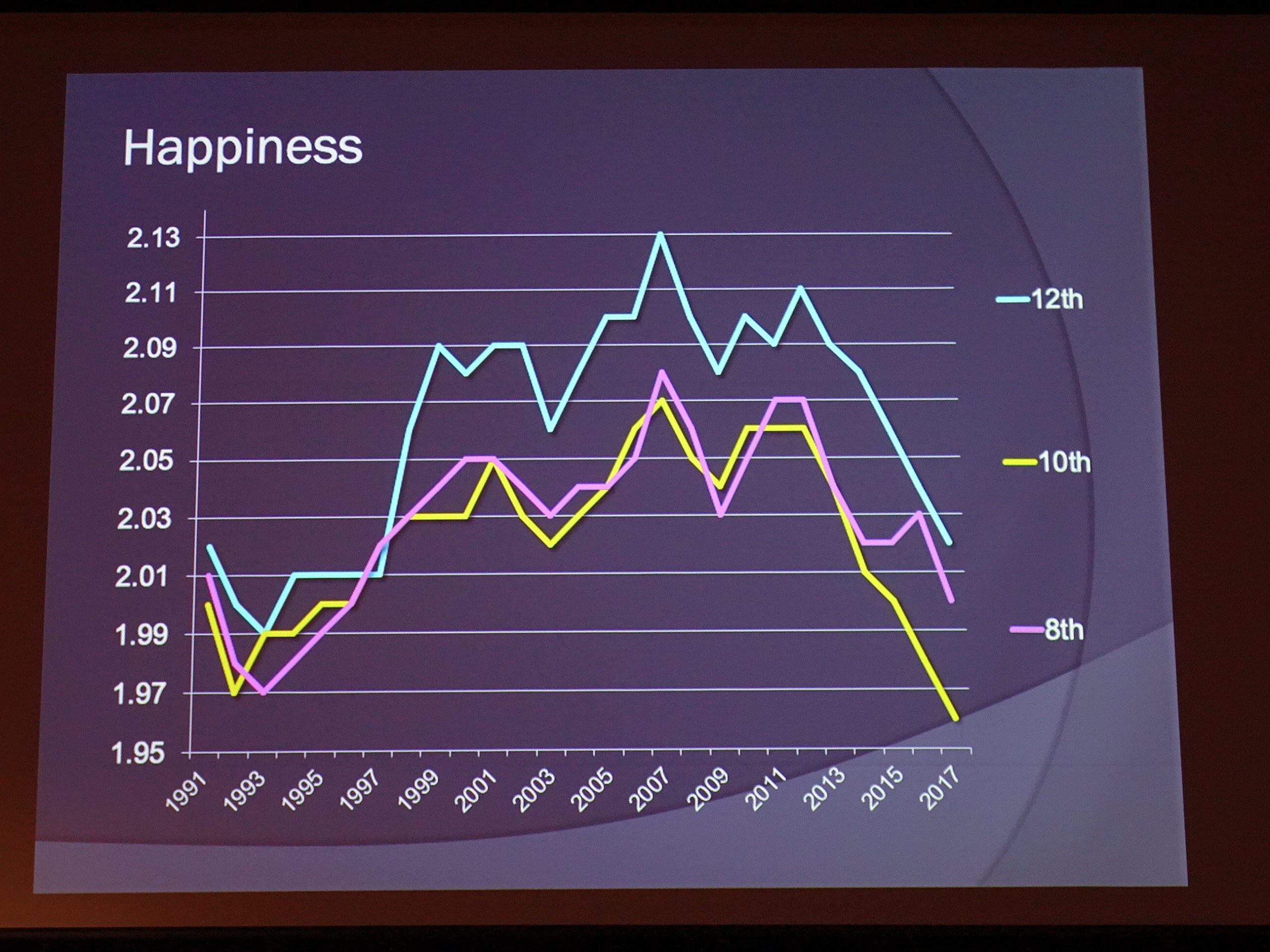
Why that year? The economic downturn was in 2008. By 2011 things were getting better.
She looked at the Pew poll: 2011 was the year that half the US population had a smartphone.
TREND 3 – TIME SPENT ON WHAT?
The third trend: What have smartphones and digital media replaced? And what are people doing with that screen time?
Young men are on something called Fortnite. I only heard of this in the past month or so. Fortnite has over 125 million users. Bigger than most countries.
Young women are more likely to be found on social media with their friends. Comparing themselves to others makes them less happy.
Either way, about 6-8 hours of screen time of entertainment and communicating with friends.
What are they not doing? Seeing each other in person is way down.
If they do go to a party, guess what they are doing?
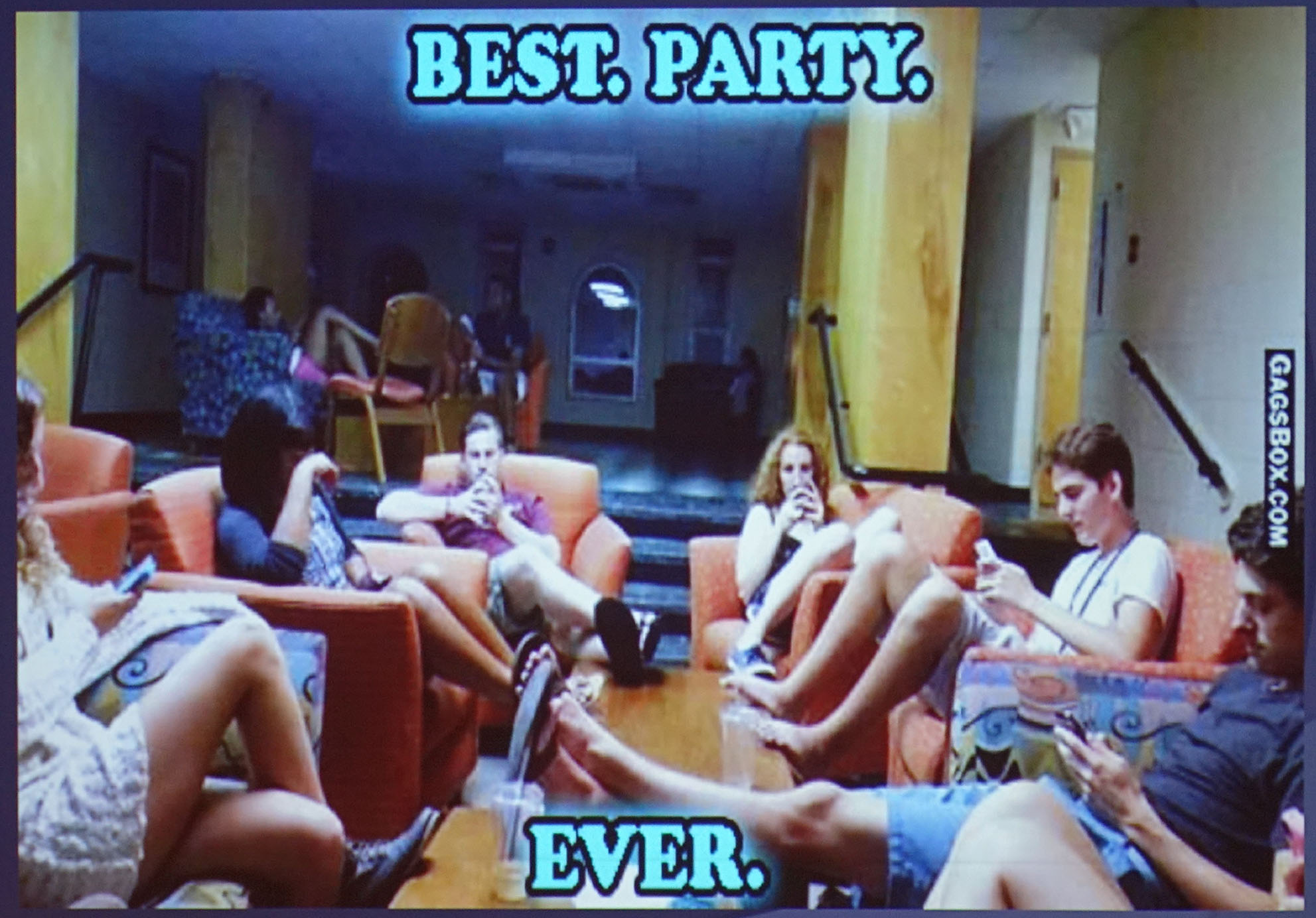
A huge hit has been to sleep time. Teens should be getting 9-10 hours per night. Almost half are getting less than 7 hours per night. In itself, that can cause many cognitive and emotional problems.
Also down:
Time going to the movie theater
Reading books or magazines
In 1976 60% of 12th graders read a book or magazine every day for leisure. That is now down to 15%!
What do happy teens do?
They sleep more than 7 hours
They are involved in sports and exercise
Or religious activities
Even homework makes them happier!
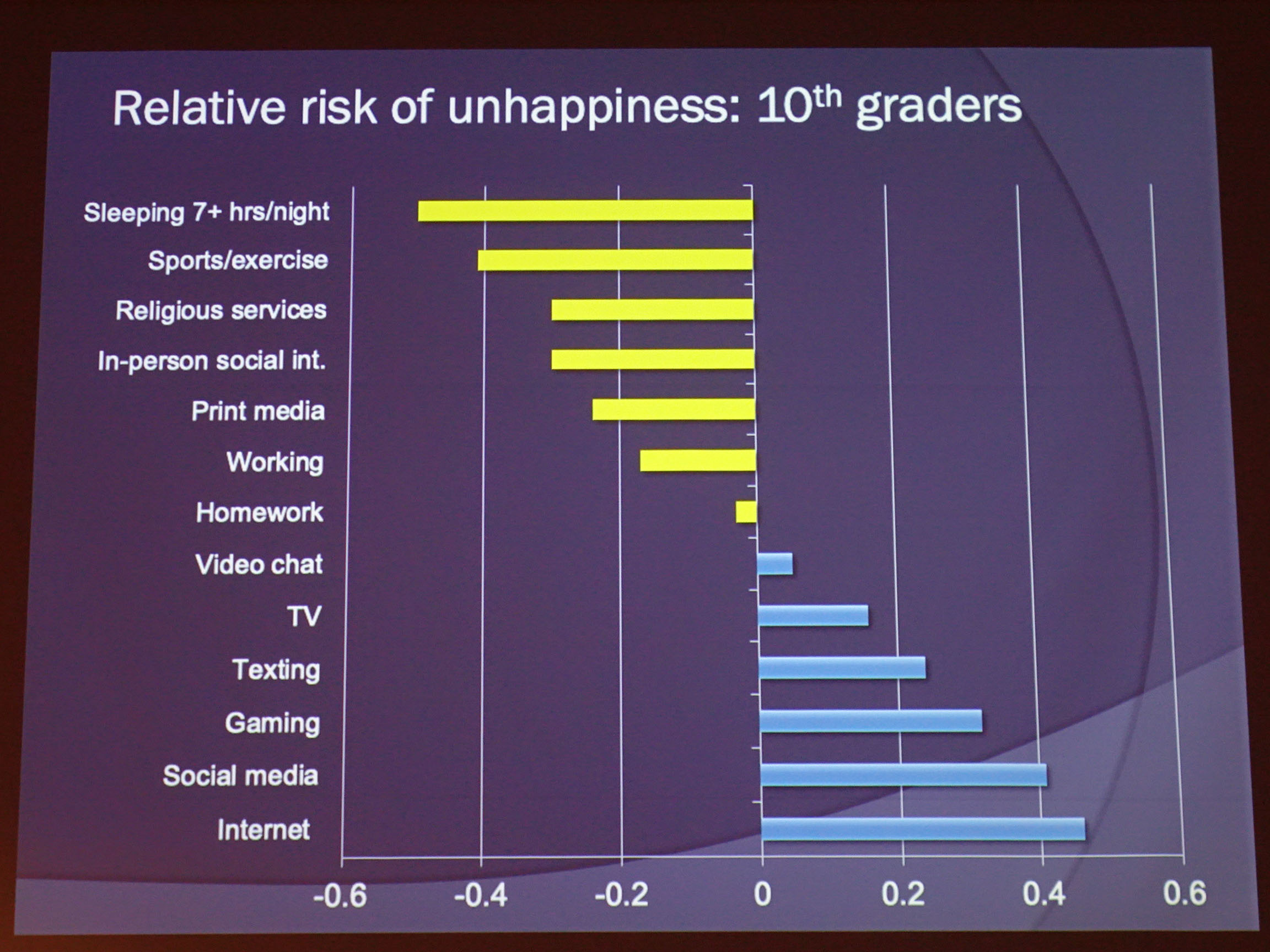
Seeing people’s faces and interacting with them makes us happier. Which seems intuitively obvious.
Twenge showed photos in China by The Theme Park Guy from 2010 and 2017.
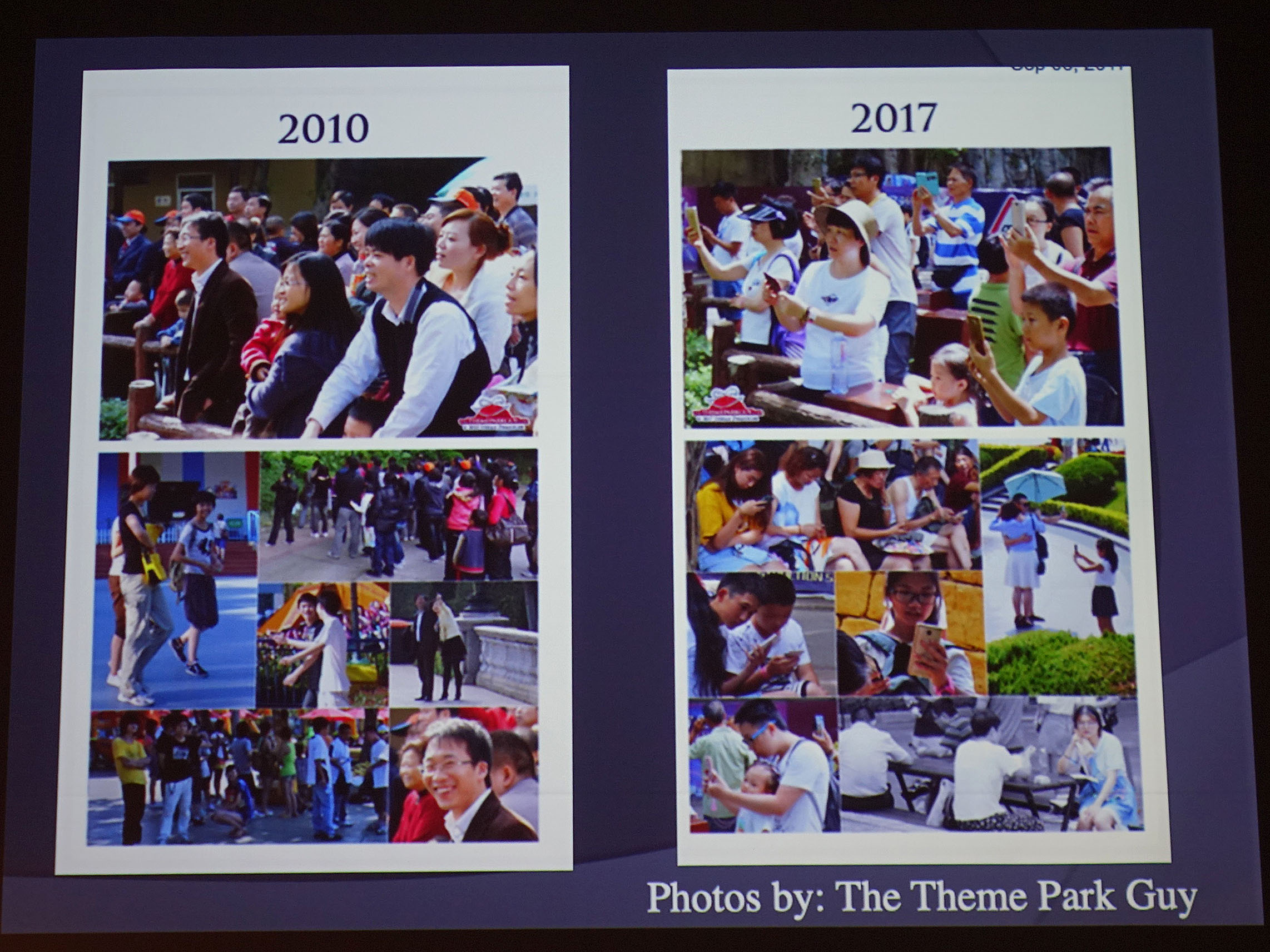
The contrast is obvious. In 2010 people are smiling and engaged. In 2017 they are either on their phones. Or they are using phones to record rather than be in the moment.
It is hard to prove cause and effect. You can’t assign people to be born at different times in history. It is hard even to assign one group to go without a smartphone. Who would they go out with?
And there could be some causation the other way. Perhaps people who feel down or lonely turn to social media.
But then there would have to be an explanation for why so many more people suddenly felt down and lonely around the exact time that smartphone use went way up.
WHAT IS TO BE DONE?
So, what is to be done?
The top priority: More sleep!
There should be no phones in the bedroom with a few exceptions. One excuse: People say they use their phone as an alarm clock. She recommends getting an alarm clock just for that purpose! Even if you have to order one on your phone!
The phone should be shut down an hour before bedtime. It is psychologically stimulating. That means stopping: Social media, texting, news and shopping an hour before bedtime.
Phones have a blue cast to their lighting. This signals it is daytime to your brain.
It is OK to read on paper. Or even on a paper-white Kindle. It even helps to wear orange tinted glasses to watch TV before bed.
The good news: So many problems are out of our control. This is in our control.
Parents need to realize that teens hanging out with each other in person is a good thing. Employers say the iGen teens are good workers. But they are not used to looking you in the eye!
Phones should be put away during social activities. Teens often find it a relief! In some groups, the teens will put all their phones in the middle of the table at a restaurant. The first one to grab their phone pays the bill for everyone!
How much is too much? There is a sweet spot around an hour a day of screen time during leisure hours. No screen time at all is as bad as too much. Phones actually allow a timer to be set!
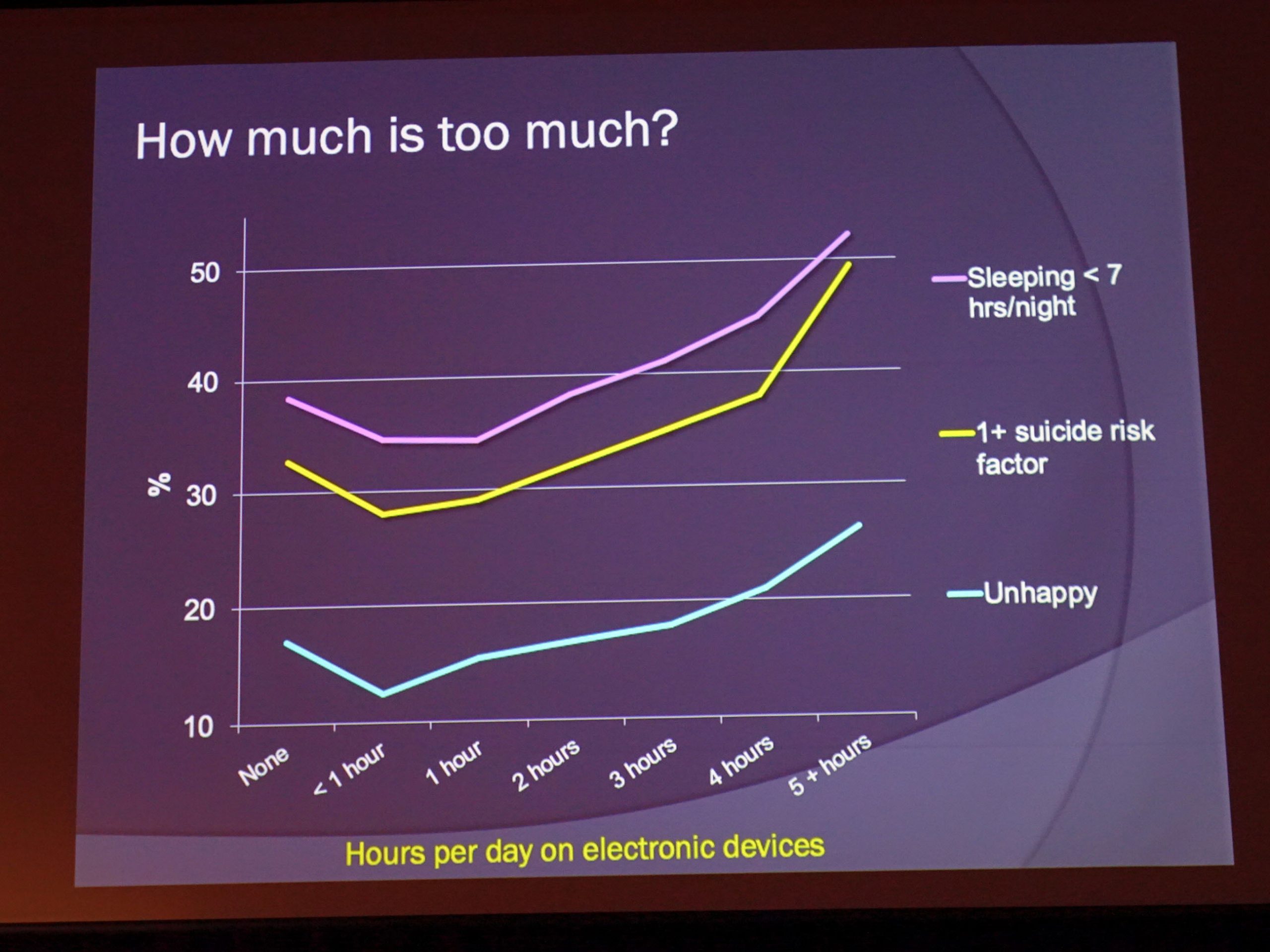
BREAK THE ADDICTION
Instead: Use that time for:
Face to face interaction
Sleep
Sports and exercise
Reading books and magazines
The idea is to break the addiction. If you don’t like the term “addiction” call it “overuse”. But remember that many apps are designed to be addicting. It is no accident.
Tristan Harris left Google to raise awareness of the addiction by design in many Silicon Valley products and services. He started the “Time Well Spent” movement. It is a movement to change the way devices are designed and used. He compares it to a stamp of approval similar to “Organic” or “LEED Certified”.
USING A TOOL VERSUS BEING A TOOL
The question to ask: Is the device a tool that you use. Or are you a tool of the device designer?
She showed a rock concert photo from 1987 where people held up lighters. Compared with 2017 where people held up phones.
The phones have uses and benefits. They can light the way. But only if we stay in control of them rather than letting them control us.
Twenge then was eager to take questions and interact with the audience. Just as she recommends we all do!
One parent wanted to know what her 12-year-old kid is supposed to do without a phone. In the old days, a kid could use the wall phone to call her friend to get together. Now no one has that wall phone to call at the friend’s house!
Twenge said her kids don’t have a phone. It is a problem; the kids have to arrange things through parents. Of course, the kid could knock on the neighbor’s door and see if the neighbor can come out to play!
HUMANS CANNOT MULTITASK
I described my experience as a rare person who does not carry a phone at all. I feel like an alien visitor from another planet as everyone walks around staring at their phones.
I will try talking to one of these people who is staring at their phone. They keep staring at their phone, insisting “Go on; I am listening.”
“No, they aren’t!” Twenge snapped back with! Twenge calls this “Phubbing” which is a combination of “phone” and “snubbing”.
“We are not computers. Humans cannot actually multitask!”
Her recommendation to another mother: Wait until 8th grade to get her kid a smartphone. Before that, the kid can have a flip phone for urgent matters. Encourage the kid to be friends with those other rare phone-free kids.
She told a story of someone posting a video of her daughter without her daughter’s approval. People need to know that is not OK.
Twenge recommended that families get back to having meals together. Without devices. Looking at each other and talking.
“SAFETY” OBSESSION CAUSES HARM
A 16-year-old girl said her parents told her to avoid all parties. That a party can “ruin your life”.
Twenge said the safety narrative has gone to an extreme. It is counter-productive. Kids need to learn independence. They need to learn responsibility.
I will add that the “safety” of kids being driven everywhere is measurably taking a toll. And not just on the environment. The greatest danger to kids walking or biking to school? Being hit by a parent driving their kid to school.
Kids are suffering from the psychological and physical health effects of never getting out and walking and biking around. Obesity and early-onset diabetes are real consequences, even though they are years in the making.
Personal experience: My brother insisted his kids walk or bike to visit friends, go to school or get to other events whenever possible. The worst problem? Other parents telling him he was a bad parent for doing this!
Teachers wanted to know how to deal with phones in the classroom. Twenge said that some schools have “phone pockets” where the kids have to leave their phones during class time.
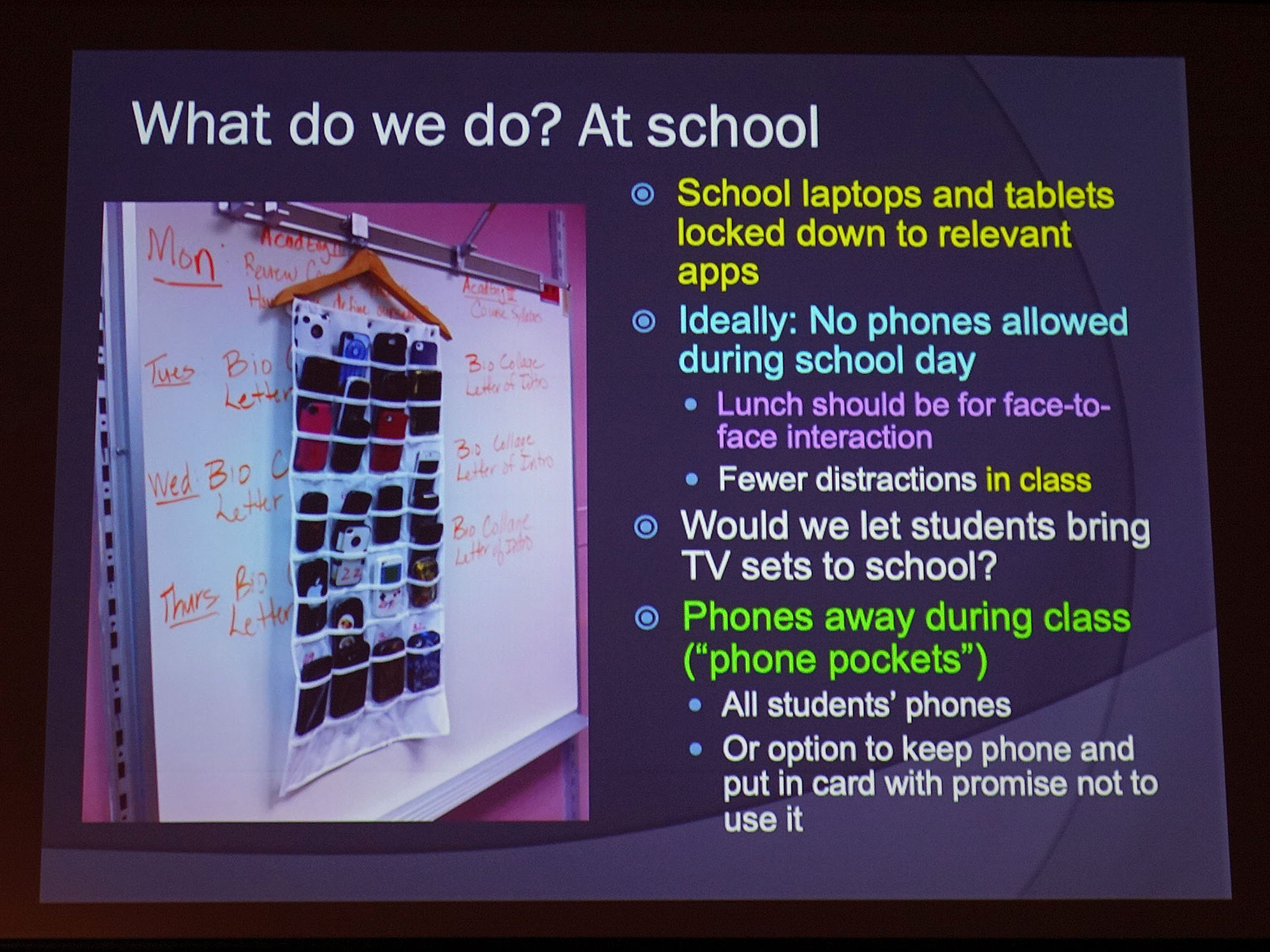
Some teachers even ban devices for note-taking. Research shows that writing longhand leads to better outcomes in learning.
And what about a parent who has to carry a phone for work? Aren’t they being hypocrites to ban phones for their kids?
Twenge said that using a device for homework or for work is a separate category. It is OK to carve out time for that. As long as we also take control of our lives and carve out time for that!





Comments
0 Comments deleted by Administrator